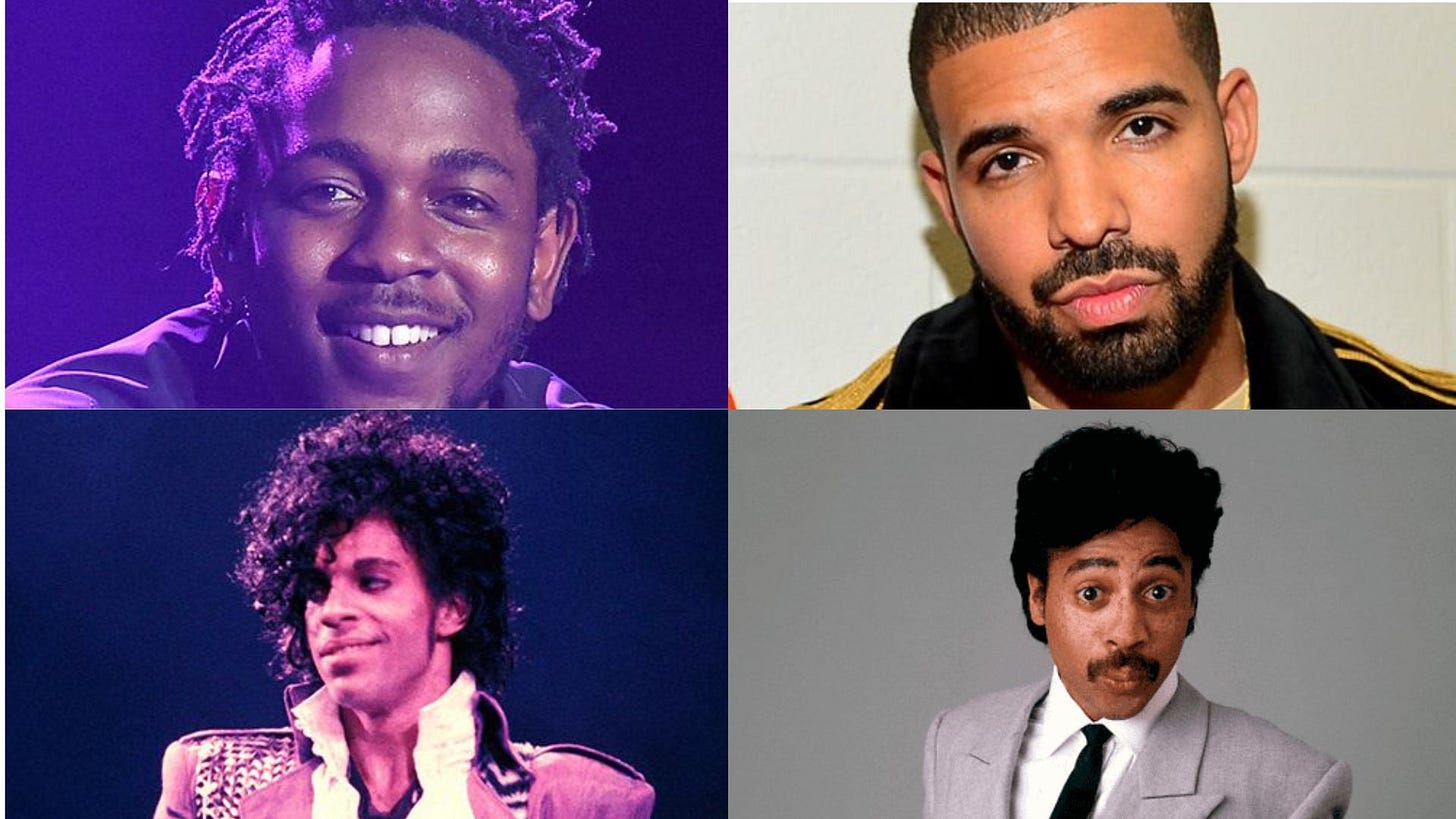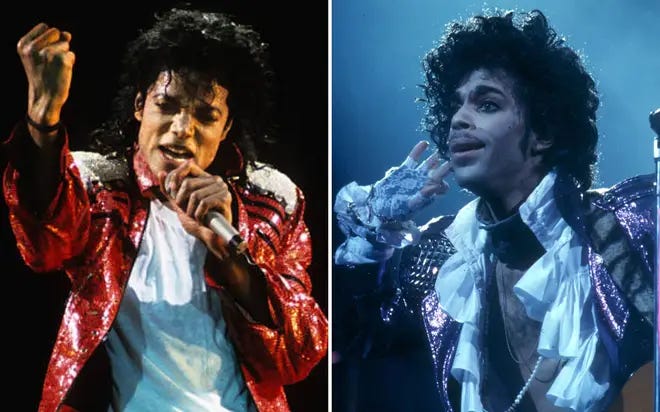Kendrick vs. Drake Was Less Prince vs. MJ and More Prince vs. Morris Day
Many talking heads were quick to compare the Kendrick Lamar/Drake rap battle as a modern-day version of Prince vs. Michael Jackson when it's closer to Prince vs. Morris Day from 'Purple Rain.'
“I’m one away from Michael,
Nigga, beat it, nigga, beat it,” - “First Person Shooter”
“I’m really like that,
Your best work is a light pack,
Nigga, Prince outlived Mike Jack” - “Like That”
“What’s a Prince to a King, a son, nigga” - “Push Ups”
“Before you figure that you’re not alone,
Ask what Mike would do” - “6:16 in L.A.”
“It’s all on your face like what happened to Mike,
Oh, shit, it’s all making sense
Maybe I’m Prince and you’re actually Mike,
Michael was praying his features would change,
So people would think that he’s actually white” - “Family Matters”
(L-R Michael Jackson and Prince. Photo credit - Getty Images)
Throughout this year’s Great Rap War between Kendrick Lamar and Drake, they traded bars that found them referencing and drawing parallels between themselves and Michael Jackson and Prince. As a result, fans took to social media to continue the comparisons, trying to figure out who was more like Prince and who was more like Jackson.
Understandably, fans, pundits, and publications were very quick to make the comparison. Jackson and Prince were the biggest artists in music during their respective primes. Today, Lamar and Drake are the biggest rappers in music in their respective primes.
Well, it’s not a clean-cut parallel. With talking heads scrambling and debating which represents Jackson and which represents Prince, it doesn’t take much analysis to realize that the analogy doesn’t fit too well.
Outside of both being respected and regarded as the two best in their field, the only real commonality deals with music release frequency. Prince was the most prolific of the two, releasing an album nearly every year of his career. Drake is easily the more prolific rapper, dropping 13 full-length projects in the last 14 years. Jackson was more scaled back when it came to his output. Between 1979 and his 2009 death, MJ only released six solo studio albums and two albums with The Jacksons. Lamar also has stretched out his projects, only releasing five proper studio albums between 2010 and now (not counting Untitled Unmastered and the Black Panther soundtrack).
To say that Prince was “more artistic” and Jackson was more “mainstream,” as some podcasters and Twitter users have, is nothing more than an oversimplification. Both artists had a peerless sense of artistry, with very idiosyncratic styles. While Prince thrived on being a renegade to a certain degree, Jackson’s decision-making as a composer was deceptively just as radical as Prince's; Jackson’s recordings were just more refined due to his collaboration with Quincy Jones and his tutelage with mentors like Berry Gordy, Stevie Wonder, and Kenny Gamble and Leon Huff.
The more accurate comparison of the Kendrick/Drake battle is Prince vs. Morris Day. The rivalry from the film Purple Rain, which celebrates its 40th anniversary today, is closer to the beef between the two 21st-century wordsmiths.
(L-R Prince and Morris Day. Photo Credit - Allen Beaulieu)
In one corner is The Kid, played by Prince, and in the other corner is Morris Day, played by, well, Morris Day. In the film, the Kid and Morris’ respective bands, The Revolution and The Time, are fighting for popularity and performance time at Minneapolis’ 1st Avenue nightclub. Lamar can be compared to The Kid and Drake can be compared to Morris.
The Kid is an eccentric, quiet character, who uses his music to express himself artistically and treats his music as an emotional catharsis from his complicated personal life. Songs like “When Doves Cry,” “Computer Blue,” “I Would Die 4 U,” and the title track depict The Kid/Prince at his most vulnerable, introspective, and religious, but are executed with an undertone of allegory and poetry.
Lamar can be likened to The Kid/Prince because his music and demeanor mirror the film’s hero. He is mysterious and reserved off-stage, but once he’s in his element, he unleashes music that is complex and poignant. Songs like “U,” “Sing About Me, I’m Dying of Thirst,” “FEAR.,” and “How Much a Dollar Cost,” find Lamar spilling his guts about his mental state, the fracturing of his family, the depths of his Christianity. Lyrically and musically, some of Lamar’s songs have an immediate impact on this listener, much like The Revolution’s “Let’s Go Crazy” did in the film’s opening scene, and some songs like “U,” or “Father Time” are harder for the audience to digest, not unlike “Computer Blue” and “Darling Nikki” in the film. Lamar dares to challenge himself and the listener for the sake of honesty.
Morris (the film character, not the real Morris) is a boisterous character, who carries himself in a brash and arrogant manner both onstage and off. His music is more about appealing to the masses. His and The Time’s songs from the film, “Jungle Love,” and “The Bird” tap into feelings that glorify sex and promote dancing, leaving very little to the imagination lyrically.
Drake can be likened to Morris Day because his music and demeanor mirror the film’s antagonist. He displays confidence in public - particularly via social media - and his onstage persona and music is far less allegorical and more to the point. Songs like “Find Your Love,” “Nice For What,” “One Dance,” and “Toosie Slide,” are seen as pop records as much as they are rap or hip-hop records. Certainly, he can be forthcoming about his feelings and emotions (see “Marvin’s Room”), but he seems to be more interested in making it plain for the listener - cutting straight to the point so they can dance or put it on their workout playlist or TikTok posts.
(L-R Morris Day and Prince. Screenshot from the 1984 film, “Purple Rain.”)
Moreover, The Kid and Morris’ differing attitudes toward women in the film also reflect Lamar and Drake, particularly when examining Lamar and Drake’s lyrics. In Purple Rain, The Kid falls for Apollonia, a beautiful woman from out of town, and fosters a romance with her. Morris, an overt misogynist, enlists Apollonia to join his all-girl group, but mainly as a weapon to antagonize his rival. During their rap battle, Drake, who excels at misogyny in songs like “All Me,” “Circo Loco,” and “Girls Want Girls,” brought up Whitney Alford, Lamar’s fiancé, and mother to their two children in his diss records “Push Ups,” “Family Matters,” and “The Heart Part 6.”
Meanwhile, Kendrick has been transparent about his failings in his relationship with Alford, via songs from Mr. Morale and The Big Steppers. Much like The Kid, Lamar is no saint, or savior as he said, but like The Kid, Lamar revealed his steps to right his wrongs and break generational curses to heal his relationship with his loved ones.
So, when you look back at this Great Rap War, don’t think of it as a 21st-century version of MJ and Prince (who never actually disliked each other). Think of it as a modern adaptation of Purple Rain, starring Lamar as The Kid and Drake as Morris Day.
THANK YOU FOR READING! If you enjoyed this piece, please subscribe to my page and share the piece on social media. Thanks again, and stay tuned for more!








Succint and informative, this post was a delight to read. Thanks for mentioning Marvin's Room, a classic and a given when naming Drake's most vulnerable (but because he's a Scorpio probably manipulative, too) songs. Doing it Wrong is another on and it's often slept on. All Me -not emotional at all - was a good one in general to remininsce on. Right or wrong, Drake's music defines eras for me and my life, and, made me think that's why you might have named the blog Def|y|ne? Bc music defines eras? And Dying of Thirst is a song that if I listen to it, I WILL cry. So thanks for mentioning those. I haven't followed the beef since it has died down but this made me feel connected to something larger in that way again.